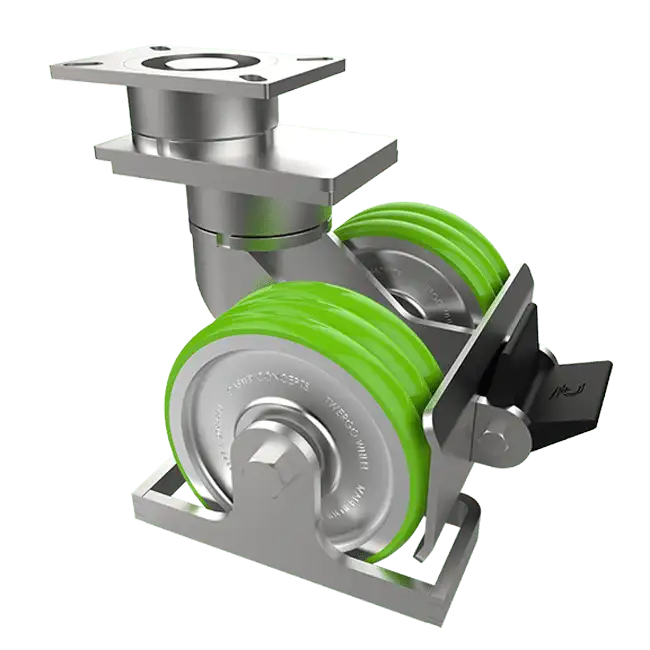

A custom made caster can be a resolution to a difficult challenge, but to achieve the greatest return, key factors must be addressed. We have identified five key factors that have the greatest impact on performance, and greatest potential causes of failure.
1. Load per caster- Knowing the load the cart/casters will be carrying is the critical first step. When you clearly understand the load, add 25-30% to that total to ensure a safe application of the product. When you have determined that total, then divide by 3. The reason for this is that no floor is perfectly flat and most times the weight is being carried on three of the four casters. Example: Load is 2000lbs times 30% equals 2600lbs. Divide 2600 lbs by 3 and the capacity per caster should be 867 lbs. This formula does not account for shock loading (dropping material on the cart). If you believe there will be shock loading in your application use a 300% factor rather than the 30% factor to figure caster capacity.
2. Speed- The next critical piece of information to obtain is the speed at which the caster will be used. While speed of transport generally has little impact on the swivel section, the design and material make up of the wheel is critical to knowing the issues with speed. While speed is important, the duration of travel time at a particular speed is also critical. The third item to consider is the speed of a particular load. A cart might travel much faster when unloaded rather than when it is loaded. Always consider the worst case scenario-fastest speed, at the highest load for the longest period of time.
3. Floor conditions- Always consider the condition of the floor when selecting the perfect caster for your application. New cement floors with no defects are very kind to caster applications. Old floors that have significant defects in them (1 deep and 3-4 in diameter) are very tough on casters and wheels. Every defect in the floor is an obstacle to the caster and can cause severe damage to the wheel, bearings in the wheel, swivel section or the welds.
4. Environment- In what environment is the caster application going to occur. Is it going to be inside at ambient temperatures, or is it going to be outside with higher or lower than ambient temperature? Is there a chance that the caster is going to be in a wet or moist application at regular intervals? Always consider the temperature of the environment while in use and the possibility of the caster having continued exposure to moisture. Both temperature and moisture will impact the selection of the caster, wheel and associated finish of the product.
5. Power driven vs. manual driven- How the caster is going to be moved in its environment is very important to consider when choosing the right caster for your application. Manual (human) driven application generally is less than 3 MPH and the forces that the caster will experience will be significantly decreased when manually pushed or pulled. On the other end of the spectrum is a fully powered application. Generally these applications will travel faster and the caster will experience much greater force in the day to day function. Be very careful when shopping for casters as most manufactures only provide ratings for manual applications (2-3 MPH). If you are using catalog specifications to meet a powered application you are well on your way to a premature caster failure.
Fortunately, we offer an web based caster search tool with custom configurator, easily search through existing caster designs based on specific parameters and view a 3D CAD model. If it is not a perfect match for your needs, simply customize it with our online configurator and view a model of your design instantly. The configurator is intelligent and knows the limits of each design, reducing the risk of issues and failure.
It is critical to specify the correct caster to fully understand the five points above. Our Caster Concepts team has skilled application engineers and technical sales people to assist you when you have a difficult application. Remember, the cost of a caster is not only the purchase price. It includes associated maintenance costs and down time that go along with the incorrect selection of a caster that was not made for your application. Users often think of casters as very simple, with minimal difference and not requiring much thought. Reality is casters carry the entire load and can have great impact on the load, the operator (ergonomics) and overall productivity. Buying off a spec sheet and online price shopping can be an expensive mistake.